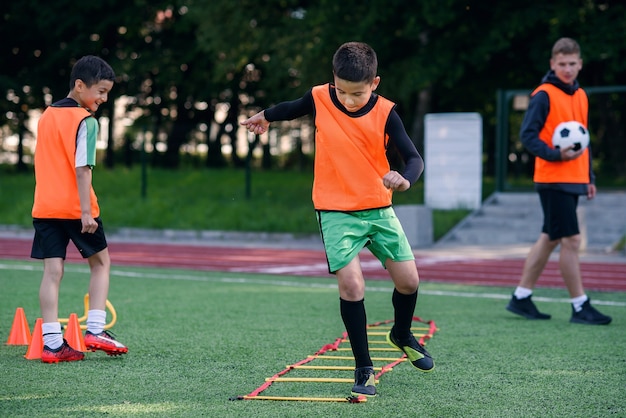Anúncios
As a passionate advocate for youth football, I can’t help but marvel at the immense impact that well-structured drills can have on our young athletes. When I first witnessed a group of beginners tackle fundamental skills through targeted exercises, it was nothing short of transformative. These drills are not just routines; they are the building blocks of skill development and teamwork, crucial aspects that shape a player’s journey on the field.
From improving ball control to fostering communication among teammates, youth football drills for beginners can propel young athletes toward remarkable accomplishments. The confidence gained through mastery of these skills doesn’t only enhance their performance but also cultivates a love for the game that can last a lifetime. In the following sections, I’ll delve deeper into how these drills can set the stage for an unforgettable football experience.
Anúncios
Why Youth Football Drills Matter
Youth football drills play a fundamental role in shaping young athletes, emphasizing not only skill development but also fostering teamwork and enhancing the overall enjoyment of the game. These drills serve as building blocks that help players, especially beginners, acquire essential skills such as passing, shooting, and dribbling. By integrating repetitive practice through various drills, youths can develop muscle memory, boosting their confidence and performance on the field.
Moreover, the significance of teamwork cannot be overstated. Drills designed for group participation encourage communication and collaboration among players, instilling a sense of unity and trust that is crucial in competitive scenarios. This aspect of training cultivates social interactions and friendships that extend beyond football, enriching their overall experience.
Furthermore, making drills enjoyable is crucial for maintaining the players’ enthusiasm for the sport. Coaches who incorporate fun elements into training activities can keep young athletes engaged and eager to improve. This enjoyment strengthens their passion for football, often leading to increased participation in future programs and a lifelong appreciation for the game.
Anúncios
Essential Drills for Beginners
When introducing young athletes to football, focusing on essential drills is crucial for developing their skills. These drills not only improve individual performance but also enhance teamwork and understanding of the game. Here’s a detailed list of effective drills for beginners, complete with descriptions and expected outcomes.
The first drill is the “Cone Dribble.” In this exercise, players weave through cones set up in a straight line, practicing ball control and agility. This develops coordination and dribbling finesse, essential for navigating opponents during a game.
The “Pass and Move” drill is another vital practice. Pair players up, instruct them to pass the ball, and immediately move to a designated spot. This encourages communication, quick decision-making, and enhances passing accuracy, vital components of team play.
Next, we have “Goal Shooting Practice.” Set up a small goal and challenge players to shoot from various distances. This helps improve shooting technique and boosts confidence in scoring situations, a key aspect of any player’s development.
The “Defensive Stance Drill” teaches beginners how to position themselves effectively against opponents. Players work in pairs, practicing proper foot placement and body positioning. Mastering this drill lays the groundwork for effective defense during actual matches.
Lastly, the “Small-Sided Games” drill allows beginners to apply their skills in a competitive environment. By playing smaller matches, players experience more touches on the ball and learn to make quicker decisions, further enhancing their overall understanding of the game.
Tips for Coaching Youth Football

Inspiring Quote
“The greatest glory in living lies not in never falling, but in rising every time we fall.” – Nelson Mandela
This powerful quote by Nelson Mandela serves as a reminder of the resilience and growth that can come from challenges, much like coaching youth football. Each drill may come with its struggles, but it is through perseverance and learning from mistakes that both coaches and young athletes can achieve greatness. Embrace the journey of coaching, knowing that every setback is a setup for a stronger comeback.
Creating a Fun Learning Environment
Creating a fun learning environment in youth football programs is essential for fostering both skill development and teamwork. By incorporating engaging activities and drills, coaches can spark enthusiasm and encourage players to actively participate. One effective strategy is to gamify practice sessions, transforming traditional drills into competitive games that promote skill execution while enhancing camaraderie among teammates.
Integrating music and themed practices can also elevate the fun factor. Playing upbeat music during warm-ups or creating themed days where players dress up adds an element of excitement. This approach not only heightens motivation but also cultivates a sense of belonging, making each player feel valued and energized to participate.
Furthermore, utilizing small-sided games allows for more touches on the ball and enhances decision-making under pressure, all while maintaining an enjoyable atmosphere. Encouraging players to set personal goals within these drills promotes individual accountability, making the process of learning more about collaboration than competition.
Measuring Progress in Young Athletes
Explore Effective Assessment Techniques for Young Athletes
For a deeper understanding of assessing young athletes’ progress through structured practices, visit: Athletic Performance Academy – Measuring Progress in Youth Athletics.